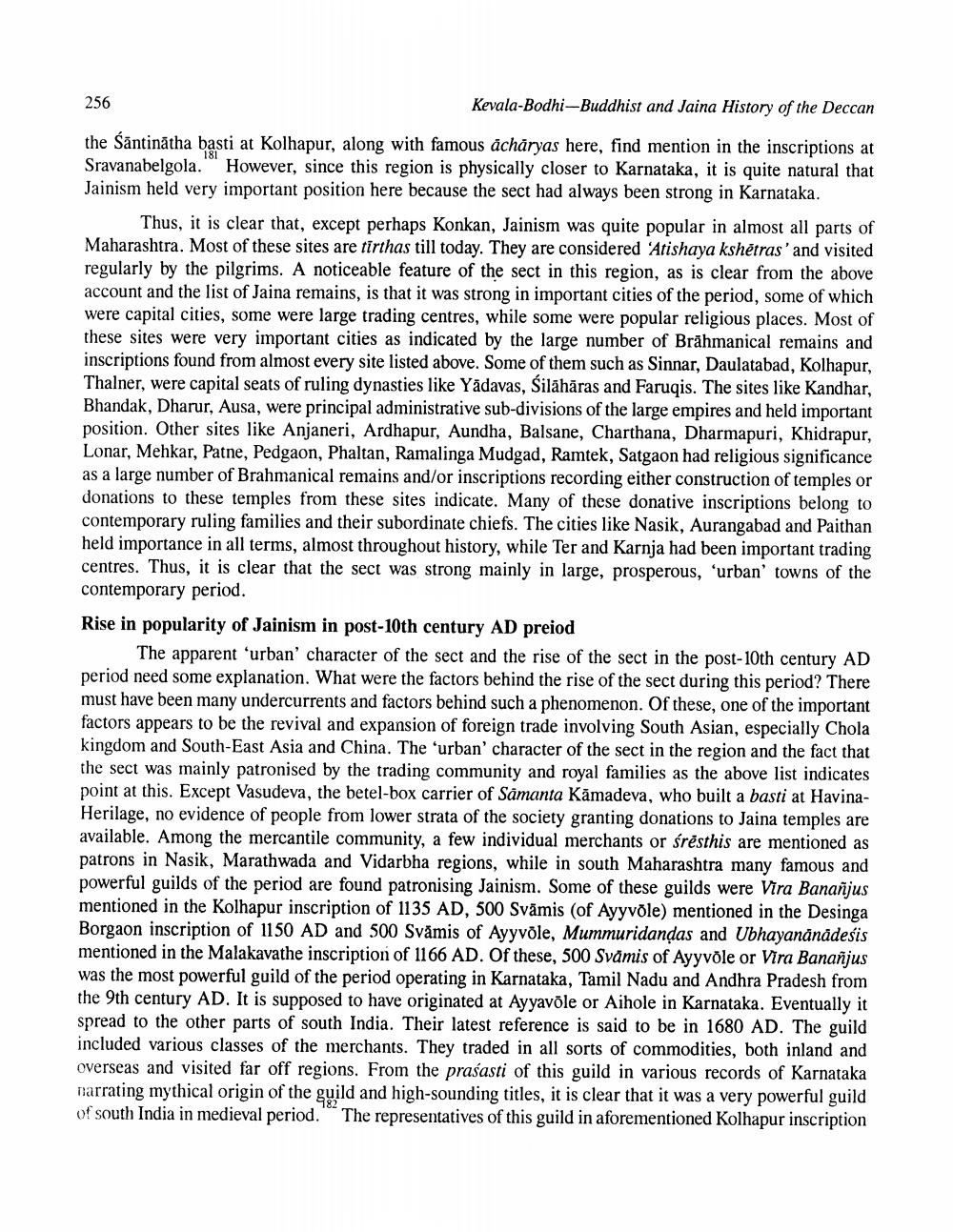________________
256
Kevala-Bodhi-Buddhist and Jaina History of the Deccan
the sấntinātha basti at Kolhapur, along with famous acharyas here, find mention in the inscriptions at Sravanabelgola. However, since this region is physically closer to Karnataka, it is quite natural that Jainism held very important position here because the sect had always been strong in Karnataka.
Thus, it is clear that, except perhaps Konkan, Jainism was quite popular in almost all parts of Maharashtra. Most of these sites are tirthas till today. They are considered 'Atishaya kshētras' and visited regularly by the pilgrims. A noticeable feature of the sect in this region, as is clear from the above account and the list of Jaina remains, is that it was strong in important cities of the period, some of which were capital cities, some were large trading centres, while some were popular religious places. Most of these sites were very important cities as indicated by the large number of Brāhmanical remains and inscriptions found from almost every site listed above. Some of them such as Sinnar, Daulatabad, Kolhapur, Thalner, were capital seats of ruling dynasties like Yādavas, Šilāhāras and Faruqis. The sites like Kandhar, Bhandak, Dharur, Ausa, were principal administrative sub-divisions of the large empires and held important position. Other sites like Anjaneri, Ardhapur, Aundha, Balsane, Charthana, Dharmapuri, Khidrapur, Lonar, Mehkar, Patne, Pedgaon, Phaltan, Ramalinga Mudgad, Ramtek, Satgaon had religious significance as a large number of Brahmanical remains and/or inscriptions recording either construction of temples or donations to these temples from these sites indicate. Many of these donative inscriptions belong to contemporary ruling families and their subordinate chiefs. The cities like Nasik, Aurangabad and Paithan held importance in all terms, almost throughout history, while Ter and Karnja had been important trading centres. Thus, it is clear that the sect was strong mainly in large, prosperous, 'urban' towns of the contemporary period. Rise in popularity of Jainism in post-10th century AD preiod
The apparent 'urban' character of the sect and the rise of the sect in the post-10th century AD period need some explanation. What were the factors behind the rise of the sect during this period? There must have been many undercurrents and factors behind such a phenomenon. Of these, one of the important factors appears to be the revival and expansion of foreign trade involving South Asian, especially Chola kingdom and South-East Asia and China. The 'urban' character of the sect in the region and the fact that the sect was mainly patronised by the trading community and royal families as the above list indicates point at this. Except Vasudeva, the betel-box carrier of Samanta Kamadeva, who built a basti at HavinaHerilage, no evidence of people from lower strata of the society granting donations to Jaina temples are available. Among the mercantile community, a few individual merchants or śrēsthis are mentioned as patrons in Nasik, Marathwada and Vidarbha regions, while in south Maharashtra many famous and powerful guilds of the period are found patronising Jainism. Some of these guilds were Vira Banañjus mentioned in the Kolhapur inscription of 1135 AD, 500 Svāmis (of Ayyvole) mentioned in the Desinga Borgaon inscription of 1150 AD and 500 Svämis of Ayyvole, Mummuridandas and Ubhayanānādesis mentioned in the Malakavathe inscription of 1166 AD. Of these, 500 Svämis of Ayyvole or Vira Bananjus was the most powerful guild of the period operating in Karnataka, Tamil Nadu and Andhra Pradesh from the 9th century AD. It is supposed to have originated at Ayyavole or Aihole in Karnataka. Eventually it spread to the other parts of south India. Their latest reference is said to be in 1680 AD. The guild included various classes of the merchants. They traded in all sorts of commodities, both inland and overseas and visited far off regions. From the prasasti of this guild in various records of Karnataka narrating mythical origin of the guild and high-sounding titles, it is clear that it was a very powerful guild of south India in medieval period. The representatives of this guild in aforementioned Kolhapur inscription




